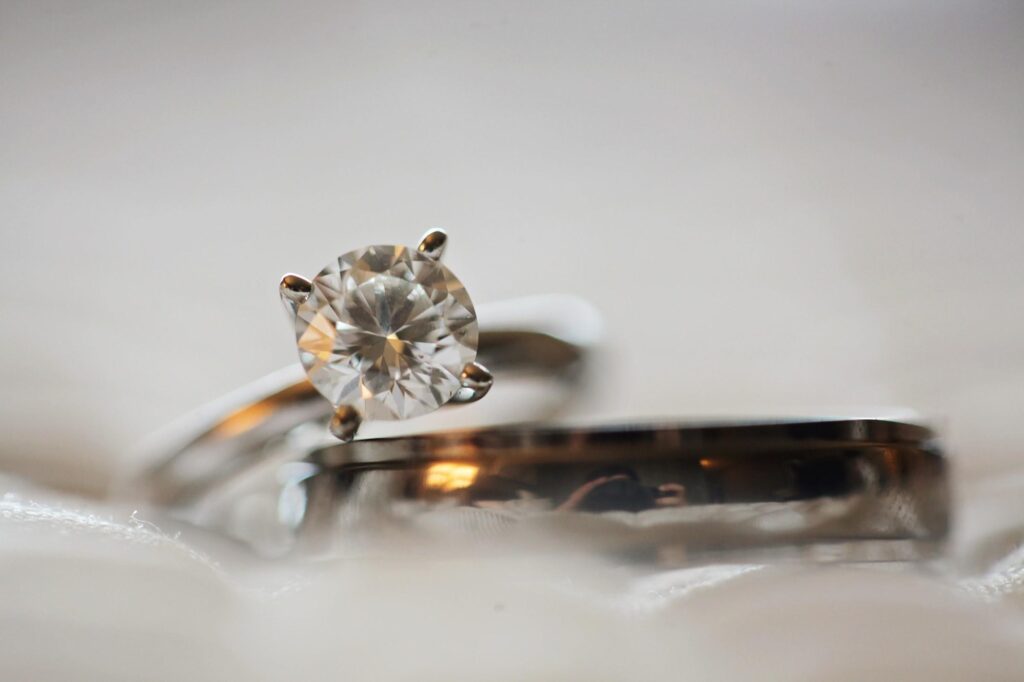
Buying a diamond does not have to be a stressful experience. Every diamond is unique and there are a variety of factors which affect the price of a diamond. Focus on those factors most important to you, and choose a diamond that satisfies your individual standards for beauty and value.
Learn more about the gorgeous gem from under the Earth’s surface…
Basic facts about white diamonds
1. The 4 C’s are the globally accepted standard for describing diamonds: Colour, Clarity, Cut and Carat Weight. Today, the 4Cs of Diamond Quality is the universal method for assessing the quality of any diamond, anywhere in the world.
2. Diamonds are not clear and can range from colourless (like a drop of pure water) to having hints of light yellow, light brown or grey. The rarity, and therefore the value, of these diamonds is based in part on how closely they approach colourlessness. All things being equal, the more colourless the diamond, the more rare and expensive it is.
3. You’ll often hear the term ‘white’ applied to colourless diamonds. This is not technically true to name diamonds colourless – as white on the colour spectrum is the sum of all colours, and upon gazing at the face of a white diamond, you will see hints and hues of the rainbow.
4. White diamonds are also sometimes described as ‘opalescent’ because of the flashes of colour which can be seen in differing lights by the eye which is similar to a white opal.
5. Lab created diamonds display the same chemical structure and physical properties as diamonds mined around the globe. Even professional gemmologists can’t tell the difference between lab created and mined diamonds without testing.
Basic facts about carats
6. The term ‘carat’ originated with early gem traders who used seeds of the carob pod as the standard for measuring weight. This is because the size of carob seeds are almost always identical. ‘Carat’ originates from the Greek word meaning “fruit of the carob tree”.
7. The most important thing to remember when it comes to carat is that while many people believe it refers to size, it actually refers to the weight.
Interesting facts about the origins and history of diamonds
8. The ancient Romans and Greeks believed that diamonds were tears cried by the gods or splinters from falling stars, and Romans believed that Cupid’s arrows were tipped with diamonds.
9. Diamonds are billions of years old—in some cases more than three billion years old.
10. Diamonds form about 100 miles below ground and have been carried to the Earth’s surface by volcanic eruptions.
11. Diamonds are made from a single element, they’re nearly 100% carbon. Under the immense heat and pressure far below the Earth’s surface, the carbon atoms bond in a unique way that results in the diamond with its beautiful and rare crystalline structure.
12. The word diamond derives from the Greek word ‘adamos’, which means invincible or indestructible. From ancient times, the adjective adamas was used to describe the hardest substance known to men.
13. Diamonds are the hardest natural substance. They have many industrial uses such as cutting, grinding, drilling, and polishing. The only thing that can scratch a diamond is another diamond. Industrial diamonds are valued as per their hardness and heat conductivity characteristics.
14. Many ancient cultures believed that diamonds gave the wearer strength and courage during battle, and some kings wore diamonds on their armour as they rode into battle. Ancient Hindus used diamonds in the eyes of devotional statues, and believed that a diamond could protect its wearer from danger.
15. During the Middle Ages diamonds were thought to have healing properties able to cure ailments ranging from fatigue to mental illness.
16. The countries which source diamonds have changed over time. India was the world’s original source of diamonds, beginning in the 1400s when Indian diamonds began to be sold in Venice and other European trading centres. Then in the 1700s India’s diamond supplies declined and Brazil became the world’s major source of diamonds, until the late 1800s when a huge diamond reserve was discovered in southern Africa. Today, diamonds are mined in many parts of the world.
17. While diamonds have created a lot of joy for people throughout history, they have too often resulted in suffering in mining communities. Remember diamonds sourced in an ethical, environmentally conscious way always shine brighter.
Things to know about famous diamonds in history
18. The first known use of a diamond ring as an engagement ring took place in 1477, when Archduke Maximilian of Austria gave Duchess Mary of Burgundy a gold ring featuring an M spelled out in diamonds.
19. Scientists have discovered a planet which could be diamond! It is composed mostly of carbon, with up to one-third pure diamond. Discovered in 2004, the planet ‘55 Cancri e’ orbits a nearby star in the Milky Way.
20. Perhaps even more amazing, scientists have discovered a star that is essentially a diamond of ten billion trillion trillion carats. The star is named ‘Lucy’ after The Beatles song ‘Lucy in the Sky with Diamonds.’ Read more about diamonds and pop culture here.
21. Considered to be the most beautiful and purest diamond in the world, the Regent Diamond is kept in Paris, France at the Louvre Museum. It has been there since 1887. It is sourced from India and is a white diamond with a pale blue hue. It was discovered in 1698 and cut by Harris in 1704 and owned by members of French royalty for generations and was even mounted to Emperor Napoleon Bonaparte’s double edged sword for a time.
by Australian Diamond Brokers : May 2nd 2018 Come visit our store or browse our website to find out more.